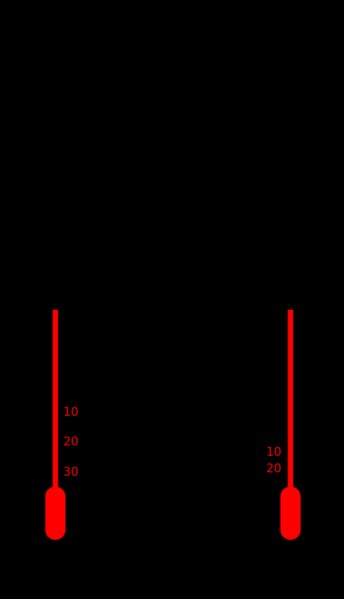Celsius and Fahrenheit are two distinct scales used to measure temperature. Understanding how they relate allows for easy conversion between the two. This article explores the differences between Celsius and Fahrenheit, their historical origins, usage, and provides formulas for converting between them.
Understanding Celsius and Fahrenheit
Fahrenheit (°F): Developed by Daniel Gabriel Fahrenheit in 1724, this scale sets the freezing point of water at 32°F and the boiling point at 212°F, with a 180°F difference between them.
Celsius (°C): Formerly known as centigrade, the Celsius scale, developed by Anders Celsius, defines the freezing point of water at 0°C and the boiling point at 100°C, resulting in a 100°C difference. This scale is defined based on absolute zero (-273.15°C) and the triple point of water (0.01°C).
 Celsius and Fahrenheit thermometers side by side compare the two scales. The freezing point of water is 0 Celsius or 32 degrees Fahrenheit. The boiling point of water is 100 Celsius or 212 degrees Fahrenheit.
Celsius and Fahrenheit thermometers side by side compare the two scales. The freezing point of water is 0 Celsius or 32 degrees Fahrenheit. The boiling point of water is 100 Celsius or 212 degrees Fahrenheit.
Converting Between Celsius and Fahrenheit
The difference in degree increments between the two scales necessitates formulas for accurate conversion:
- Fahrenheit to Celsius: °C = (°F – 32) x 5/9
- Celsius to Fahrenheit: °F = (°C x 9/5) + 32
Using -40° as an example:
- Fahrenheit to Celsius: (-40°F – 32) x 5/9 = -40°C
- Celsius to Fahrenheit: (-40°C x 9/5) + 32 = -40°F
This demonstrates that -40° is the point where both scales intersect.
Global Usage of Celsius and Fahrenheit
While the United States continues to use Fahrenheit for everyday purposes, most other countries have adopted Celsius. Some older generations in English-speaking countries may still use Fahrenheit, particularly for higher temperatures. Although the UK has largely switched to Celsius, some media outlets still provide temperatures in both scales for audiences familiar with Fahrenheit. The shift to Celsius in many countries reflects a broader adoption of the metric system.
Historical Context of Temperature Scales
Historically, Fahrenheit was prevalent in English-speaking countries for various applications until the 1960s, when governments started transitioning to Celsius as part of metrication efforts. Proponents of Fahrenheit argued for its finer increments, allowing for more precise measurements without fractions. They also pointed out that the typical temperature range in inhabited areas often falls between 0°F and 100°F. However, Celsius advocates contend that their system is equally intuitive, citing temperature ranges like 0-10°C for cold, 10-20°C for mild, and so on.
Relationship with the Kelvin Scale
Both Celsius and Fahrenheit can be related to the Kelvin scale, the SI unit of temperature:
- Kelvin to Fahrenheit: °F = (K × 9/5) − 459.67
- Fahrenheit to Kelvin: K = (°F + 459.67) ÷ 1.8
- Kelvin to Celsius: °C = K − 273.15
- Celsius to Kelvin: K = °C + 273.15
Conclusion
Celsius and Fahrenheit offer different ways to quantify temperature. Understanding their conversion formulas and historical context is essential for interpreting temperature readings accurately. While global usage varies, the ability to convert between the two ensures clear communication of temperature information.

